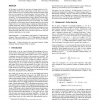Free Online Productivity Tools
i2Speak
i2Symbol
i2OCR
iTex2Img
iWeb2Print
iWeb2Shot
i2Type
iPdf2Split
iPdf2Merge
i2Bopomofo
i2Arabic
i2Style
i2Image
i2PDF
iLatex2Rtf
Sci2ools
ETRA
2010
ACM
2010
ACM
Learning relevant eye movement feature spaces across users
In this paper we predict the relevance of images based on a lowdimensional feature space found using several users’ eye movements. Each user is given an image-based search task, during which their eye movements are extracted using a Tobii eye-tracker. The users also provide us with explicit feedback regarding the relevance of images. We demonstrate that by using a greedy Nystr¨om algorithm on the eye movement features of different users, we can find a suitable low-dimensional feature space for learning. We validate the suitability of this feature space by projecting the eye movement features of a new user into this space, training an online learning algorithm using these features, and showing that the number of mistakes (regret over time) made in predicting relevant images is lower than when using the original eye movement features. We also plot Recall-Precision and ROC curves, and use a sign test to verify the statistical significance of our results. CR Categories: G.3 [Probabil...
| Added | 17 May 2010 |
| Updated | 17 May 2010 |
| Type | Conference |
| Year | 2010 |
| Where | ETRA |
| Authors | Zakria Hussain, Kitsuchart Pasupa, John Shawe-Taylor |
Comments (0)

